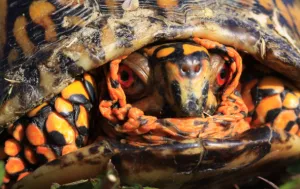
Table of Contents
Scientific Classification
- Kingdom: Animalia
- Phylum: Chordata
- Class: Reptilia
- Order: Testudines
- Family: Emydidae
- Genus: Terrapene
- Species: Terrapene carolina
Quick Overview
The Eastern Box Turtle (Terrapene carolina) stands as a captivating and terrestrial turtle species native to the eastern part of the United States. Recognized for its distinct appearance and the ability to completely enclose itself within its shell, the Eastern Box Turtle has garnered appreciation among reptile enthusiasts.
Fast Facts
- Scientific Name: Terrapene carolina
- Lifespan: Eastern Box Turtles are known for their longevity, often living 40 years or more in captivity.
- Average Size: Adult Eastern Box Turtles typically have a shell length of 4.5 to 6 inches.
- Diet: Omnivorous, with a varied diet that includes insects, earthworms, fruits, and vegetation.
- Habitat: Terrestrial, found in a variety of habitats including forests, grasslands, and wetlands.
Did you know?
Eastern Box Turtles have a unique hinged plastron (lower shell), allowing them to completely close their shell for protection.
Appearance
Eastern Box Turtles exhibit a distinctive appearance with a high, domed carapace (upper shell) featuring intricate patterns. The carapace can vary in coloration, including shades of brown, yellow, and black. The plastron may have dark markings, and the skin and head often display vibrant colors. Notably, the shell is hinged at the bottom, allowing the turtle to shut itself securely within its protective shell.

Size and Weight
Adult Eastern Box Turtles typically reach a shell length of 4.5 to 6 inches, with females generally being larger than males. Their weight varies but is usually between 300 and 500 grams.
Temperament and Behavior
Eastern Box Turtles are known for their shy and solitary nature. They spend a significant amount of time on land but are competent swimmers. These turtles often display distinct personalities, and some individuals may become accustomed to human interaction.
Fun Fact
Eastern Box Turtles have a remarkable homing instinct, often traveling back to the same location year after year.
Habitat and Distribution
Native to the eastern United States, Eastern Box Turtles are adaptable and inhabit a range of environments. They can be found in deciduous forests, meadows, and areas with moist soils for digging.
Care Guide
For those interested in keeping Eastern Box Turtles as pets:
- Enclosure: Provide a secure outdoor enclosure with hiding spots, substrate for digging, and a shallow water dish.
- Temperature: Ensure a basking area temperature around 85-90°F (29-32°C) and a cooler area around 70°F (21°C).
- Diet: Offer a varied diet, including insects, vegetables, fruits, and calcium supplements.
- Health Check-ups: Regularly monitor your pet’s health, including eyes, nose, and shell, and seek veterinary care when needed.
Diet and Nutrition
Eastern Box Turtles are omnivores, and their diet should include a mix of animal and plant matter. Calcium supplements are crucial for their shell health, especially in captivity.
Health and Wellness
Maintaining proper humidity, a balanced diet, and access to sunlight or UVB lighting are essential for the overall health and well-being of Eastern Box Turtles.
Reproduction
Eastern Box Turtles reproduce by laying eggs in sandy or loamy soil. The gender of the offspring is influenced by the incubation temperature.
Conservation Status
While not currently classified as endangered, Eastern Box Turtles face threats such as habitat loss and road mortality. Conservation efforts focus on preserving their natural habitats.
Photo Gallery




Related Profiles
Share This Profile
Three Fascinating Facts About Eastern Box Turtles
- Longevity: Eastern Box Turtles are known for their impressive lifespan, with some individuals living over 100 years in the wild.
- Territorial Behavior: These turtles exhibit territorial behavior and may establish home ranges, returning to familiar locations.
- Natural Sunscreen: Eastern Box Turtles produce a substance on their skin that acts as a natural sunscreen, protecting them from harmful UV rays.
- Enchi Ball Python: A Unique and Stunning Morph of Python regius - March 27, 2025
- Emerald Tree Monitor: The Enigmatic Green Guardian of the Rainforest - March 26, 2025
- The Egyptian Cobra (Naja haje): A Fascinating Serpent - March 25, 2025
